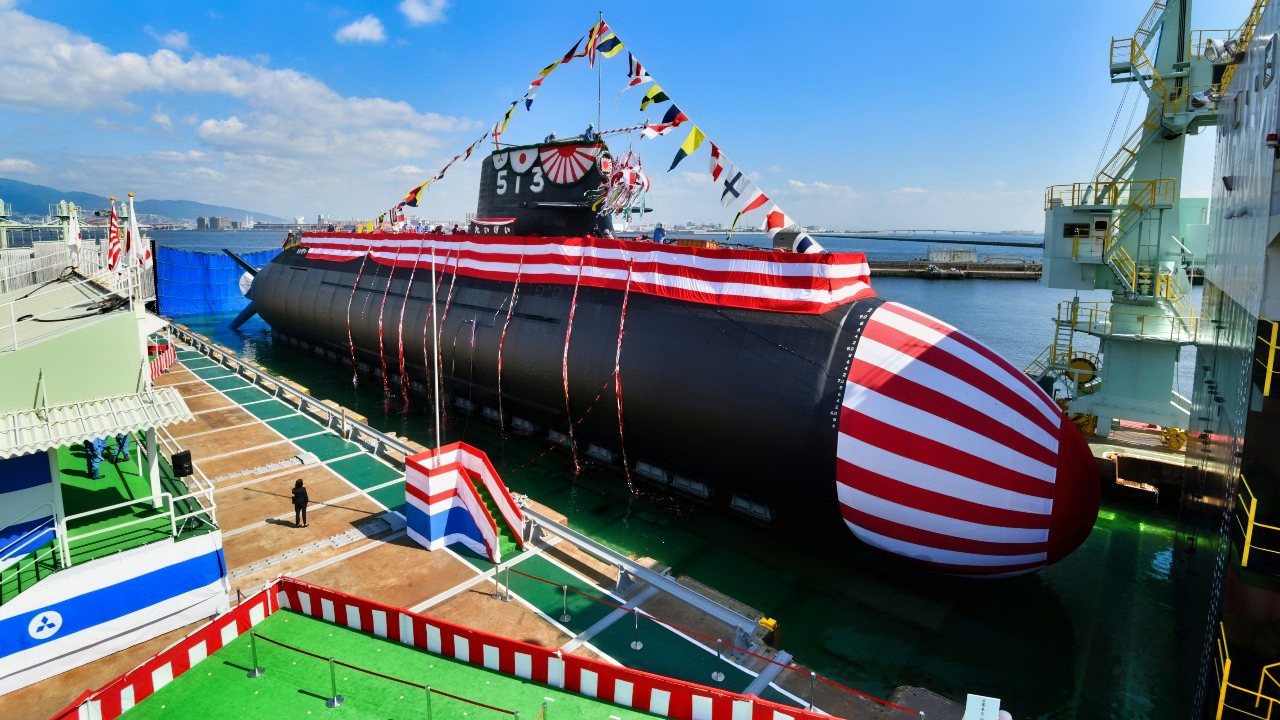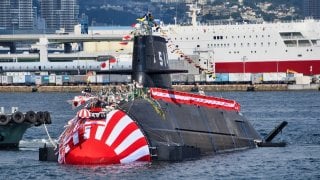Japan Is Looking to Become a Submarine Powerhouse
Japan’s Maritime Self-Defense Force (JMSDF) launched its fifth Taigei-class submarine, JS Chogei, as part of a planned fleet of eight advanced diesel-electric attack submarines. Scheduled for commissioning in 2026, the Chogei is designed with enhanced propulsion and offensive capabilities to counter China’s growing naval presence.
What You Need To Know: Japan’s Maritime Self-Defense Force (JMSDF) launched its fifth Taigei-class submarine, JS Chogei, as part of a planned fleet of eight advanced diesel-electric attack submarines. Scheduled for commissioning in 2026, the Chogei is designed with enhanced propulsion and offensive capabilities to counter China’s growing naval presence.

-These submarines can launch Type 18 and Type 89 heavyweight torpedoes and UGM-48 Harpoon missiles.
-The Taigei-class features quieter operation, improved diesel engines, and accommodations for female sailors. Japan is ramping up its defense capabilities, with three more subs under construction, but may require additional numbers to counter threats from China and North Korea.
Japan Launches Fifth Taigei-Class Submarine to Counter Growing Chinese Threat
The fifth of a planned eight Japanese Maritime Self-Defense Force (JMSDF) attack submarines was launched last Friday at a ceremony at Mitsubishi Heavy Industries' Kobe Shipyard. The future JS Chogei – the latest Taigei-class diesel-electric attack submarine (SSK) to be launched – is on track to be commissioned in early 2026. It will be the first Japanese vessel to bear the name, which means "long whale" in Japanese.
The lead sub JS Taigei was commissioned in March 2022, while Tokyo approved funding for the full eight boats in fiscal year 2024 (FY24). All of the boats of the class incorporate "gei" (whale) into their names – and "Taigei" translates to "big whale."
Looking to Counter China's Sub Buildup
Tokyo has increased its defense spending and has put an increased emphasis on its naval capabilities – even reinterpreting how the nation's post-World War II pacifist constitution banned weapons that can be offensively.
As reported by Maya Carlin for The National Interest, "The (Taigei-class) submarines are able to launch Japan's newest Type 18 heavyweight torpedoes or Mitsuishi-built Type 89 heavyweight homing torpedoes via its six 21-inch bow torpedo tubes. Additionally, the Taigei boats can launch UGM-48 Harpoon anti-ship missiles. The missile range of the Harpoon is 248 kmenough to provide Japan with a 'counterattack' capability."
The class has also seen improvements to its propulsion system.
"The newly launched SSK will use the new Kawasaki 12V 25/31 diesel engines with high output power, following the fourth Taigei-class submarine 'Raigei,'" Naval News reported. In addition to higher output, the improved diesel engines are also "compatible with a new snorkel system with enhanced power generation efficiency."
Each of the Taigei-class submarines displaces roughly 3,000 tons, larger than the preceding Soryu class, while each measures around 84 meters in length with a beam of 9.1 meters.
"These submarines notably feature sophisticated absorbent materials and high-strength steel to ensure a quieter operation and high water pressure resistance," Carlin added.
What is also noteworthy is that the Taigei-class was designed to accommodate up to six women sailors – a first for any Japanese submarine. This includes female-only compartments including private living space. Each of the boats is typically operated by a crew of 70.

The JMSDF Sub Fleet
Currently, the JMSDF operates 22 submarines in two flotillas that are divided into five squadrons. According to the Nuclear Threat Initiative, "The First and Second Submarine Flotillas are based at Kura and Yokosuka respectively."
All of the nearly two-dozen subs are diesel-electric, and were constructed by Mitsubishi Heavy Industries and Kawasaki Shipbuilding Corporation.
Three additional Taigei-class submarines are now in various stages of construction, and all are scheduled to be launched by 2027 and in service by 2030 to counter threats from Beijing and Pyongyang. Though significantly more advanced, the JMSDF fleet of subs will be smaller in number than what Tokyo operated during the Second World War. However, of the total of 174 submarines built before and after World War II, three-quarters (128) were lost in the conflict.
To successfully confront China and/or North Korea, Japan may need more advanced subs in greater numbers.
Author Experience and Expertise: Peter Suciu
Peter Suciu is a Michigan-based writer. He has contributed to more than four dozen magazines, newspapers, and websites with over 3,200 published pieces over a twenty-year career in journalism. He regularly writes about military hardware, firearms history, cybersecurity, politics, and international affairs. Peter is also a Contributing Writer for Forbes and Clearance Jobs. You can follow him on Twitter: @PeterSuciu. You can email the author: [email protected].
Image Credit: Creative Commons and/or Shutterstock.


